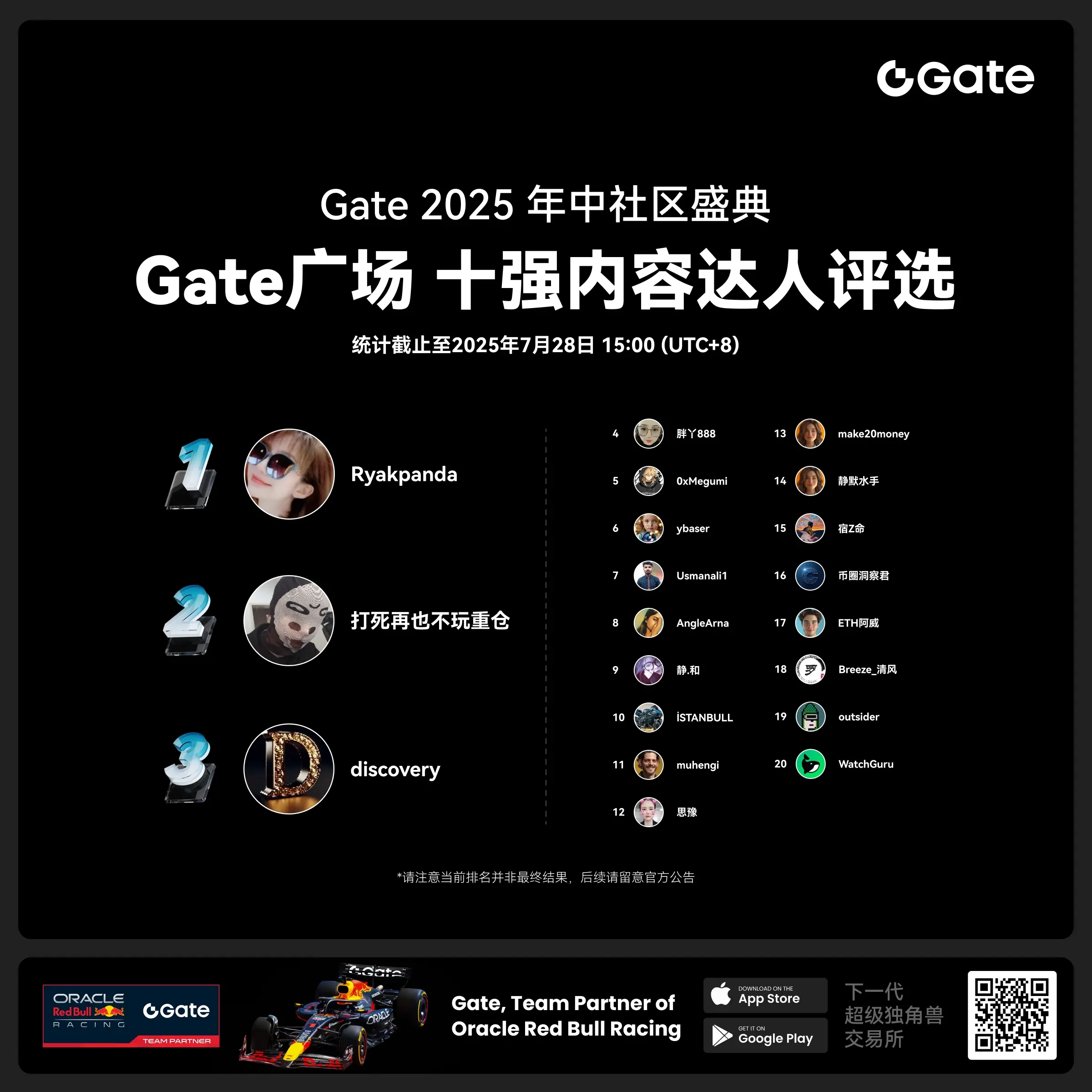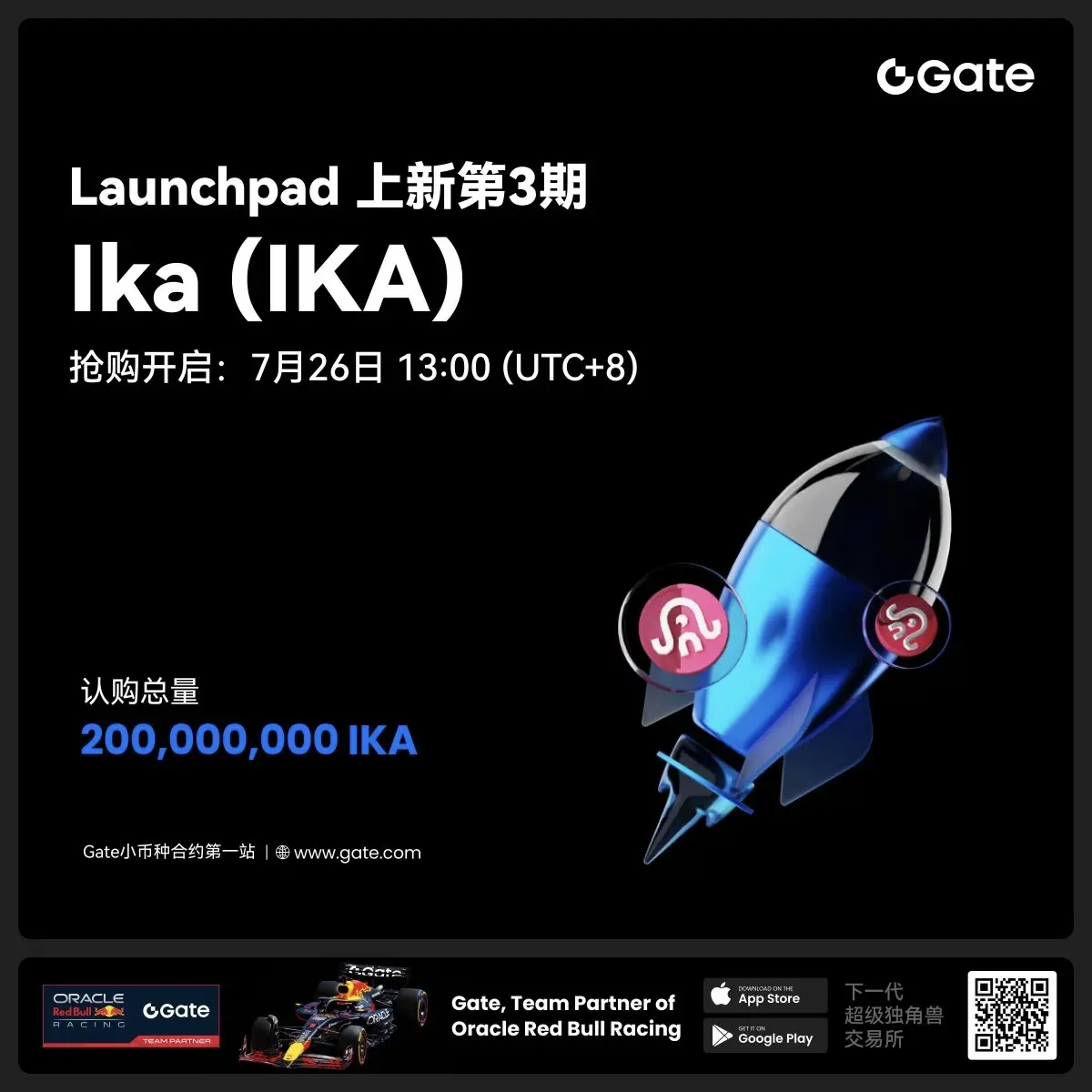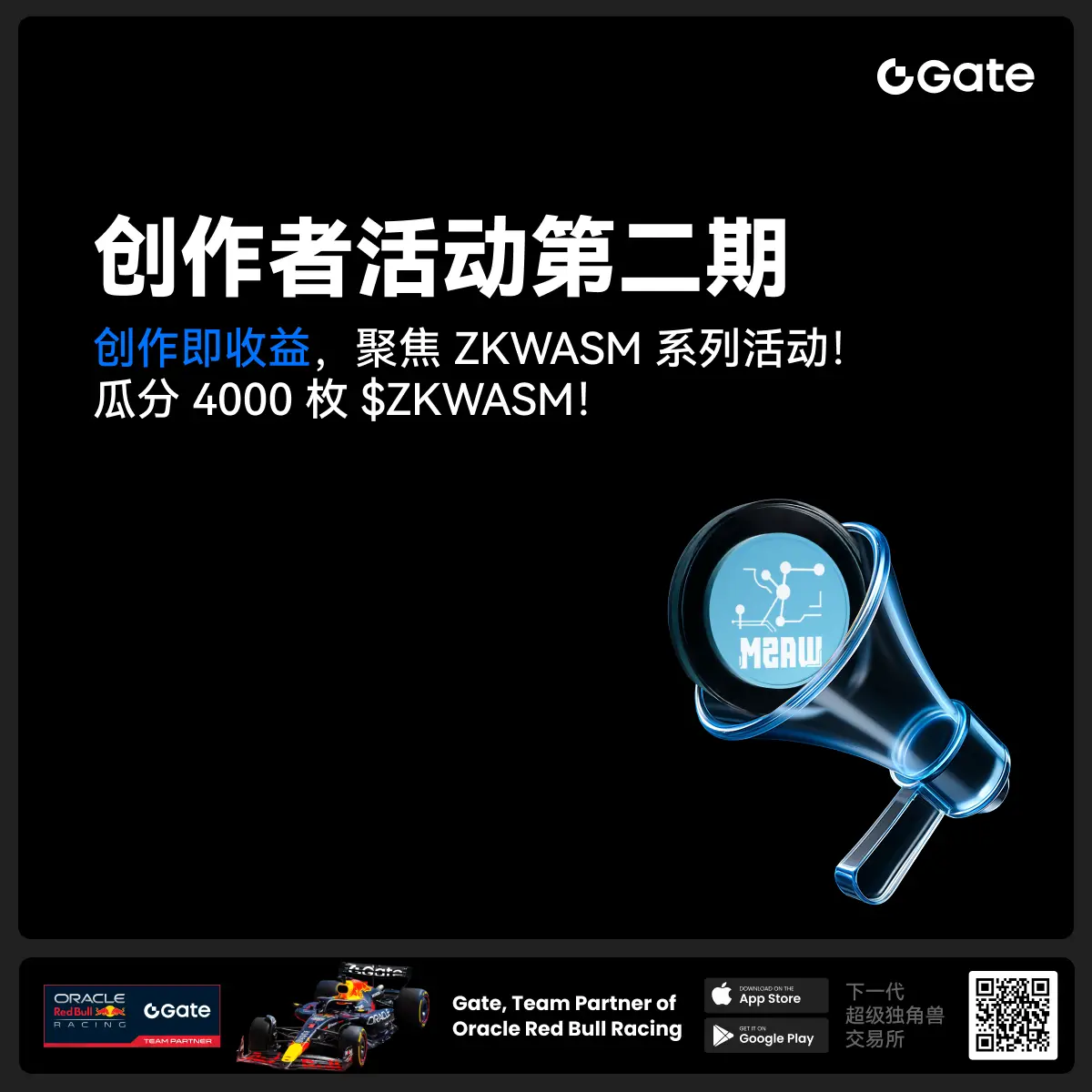- 話題1/3
58k 熱度
48k 熱度
2k 熱度
18k 熱度
151 熱度
- 置頂
- 🎉 親愛的廣場小夥伴們,福利不停,精彩不斷!目前廣場上這些熱門發帖贏獎活動火熱進行中,發帖越多,獎勵越多,快來GET你的專屬好禮吧!🚀
1️⃣ #GateLaunchpad上线IKA# |IKA認購體驗
在Gate廣場帶話題曬出你的IKA Launchpad認購體驗,4位幸運分享者講瓜分$200分享獎池!
詳情 👉️ https://www.gate.com/post/status/12566958
2️⃣ #ETH冲击4800# |行情分析預測
大膽發帖預測ETH走勢,展示你的市場洞察力!10位幸運用戶將平分0.1 ETH 獎勵!
詳情 👉️ https://www.gate.com/post/status/12322403
3️⃣ #创作者活动第二期# |ZKWASM話題
在廣場或推特發布與 ZKWASM 或其交易活動相關的原創內容,瓜分4,000枚ZKWASM!
詳情 👉️ https://www.gate.com/post/status/12525794
4️⃣ #Gate广场征文活动第二期# |ERA話題
談談你對ERA的觀點/體驗,參與並推廣活動,700 ERA大獎等你贏!
詳情 👉️ https://www.gate.com/post/status/12361653
5️⃣ #MBG任务挑战# |MBG話題
分享你對MBG的洞察,積極參與和推廣MBG活動,20位小 - 親愛的廣場用戶們, #Gate 2025年中社区盛典# 投票中!🔥
🙌 廣場內容達人TOP40榜單新鮮出爐!速速圍觀榜單,爲你喜愛的達人瘋狂打call吧:
www.gate.com/activities/community-vote
每天完成【廣場】互動任務可獲得助力值,每投出30助力值即可參與抽獎一次!
iPhone 16 Pro Max 512G、金牛雕塑、潮流運動套裝、合約體驗券、熱門幣種等你抽!
助力越多,中獎機率越大,下一個抱走iPhone 16的錦鯉就是你!🧧
別猶豫,帶上你的“歐氣”,爲達人衝榜贏大獎!
https://www.gate.com/announcements/article/45974
- 🎉 Gate 廣場 IKA Launchpad 發帖活動來襲!🎉
Gate Launchpad 認購 IKA 最後24小時!曬出你的認購體驗,和大家一起分享,每個人都有機會瓜分 $200 獎池!
🎁 4位幸運分享者*$50合約體驗券每人!
🧐 如何參與:
1.在廣場發帖,帶上 #GateLaunchpad上线IKA# 標籤
2.曬出你的認購截圖 或 分享你的獨特認購小竅門/心得或趣事
3.保證帖子大於50字,內容有趣有料,原創,集齊至少3個互動(點讚/評論/轉發)
IKA認購連結:https://www.gate.com/launchpad/2336?downgarde=true
活動時間:7月28日 12:00 - 7月30日 24:00 (UTC+8)
趕快加入,分享你的精彩時刻,你就是下一個幸運兒!
- 📢 Gate廣場 #创作者活动第二期# 正式開啓!
聚焦 ZKWASM 系列活動,分享你的觀點,瓜分 4,000 枚 $ZKWASM!
ZKWASM 作爲 zk 公鏈先鋒,正在 Gate 平台重磅推廣!
三大活動聯動上線:Launchpool 認購、CandyDrop 空投、Alpha 專屬交易——不要錯過!
🎨 活動一:發布廣場貼文,贏內容獎勵
📅 時間:7月25日 22:00 - 7月29日 22:00(UTC+8)
📌 參與方式:
- 在 Gate 廣場發布與 ZKWASM 或其三大活動相關的原創內容(不少於 100 字)
- 添加標籤: #创作者活动第二期# #ZKWASM#
- 附本人參與 Launchpool/CandyDrop/Alpha 的截圖(如認購、空投或交易)
🏆 獎勵設置:
- 一等獎(1名):1000 枚 $ZKWASM
- 二等獎(2名):500 枚 $ZKWASM
- 三等獎(10名):100 枚 $ZKWASM
📋 評選標準:內容質量、互動量、項目相關性,附活動參與截圖者優先。
📢 活動二:發推贏傳播力獎勵
📌 參與方式:
- 在 X(推特)發布與 ZKWASM 或三大活動相關的原創內容(不少於 100 字)
- 添加標籤: #ZKWASM # GateSquare
- 填寫登記表 👉 https://www.gate.com/quest
- 📢 Gate廣場 #MBG任务挑战# 發帖贏大獎活動火熱開啓!
想要瓜分1,000枚MBG?現在就來參與,展示你的洞察與實操,成爲MBG推廣達人!
💰️ 本期將評選出20位優質發帖用戶,每人可輕鬆獲得50枚MBG!
如何參與:
1️⃣ 調研MBG項目
對MBG的基本面、社區治理、發展目標、代幣經濟模型等方面進行研究,分享你對項目的深度研究。
2️⃣ 參與並分享真實體驗
參與MBG相關活動(包括CandyDrop、Launchpool或現貨交易),並曬出你的參與截圖、收益圖或實用教程。可以是收益展示、簡明易懂的新手攻略、小竅門,也可以是現貨行情點位分析,內容詳實優先。
3️⃣ 鼓勵帶新互動
如果你的帖子吸引到他人參與活動,或者有好友評論“已參與/已交易”,將大幅提升你的獲獎概率!
MBG熱門活動(帖文需附下列活動連結):
Gate第287期Launchpool:MBG — 質押ETH、MBG即可免費瓜分112,500 MBG,每小時領取獎勵!參與攻略見公告:https://www.gate.com/announcements/article/46230
Gate CandyDrop第55期:CandyDrop x MBG — 通過首次交易、交易MBG、邀請好友註冊交易即可分187,500 MBG!參與攻略見公告:https://www.gate.com/announcements
Kaia公鏈啓動韓元穩定幣計劃 能否開啓新一輪穩定幣浪潮
Kaia公鏈瞄準韓國穩定幣市場,能否開啓"穩定幣夏季"?
近期,Kaia公鏈憑藉其代幣價格的強勁漲成爲加密市場的熱門話題。自2024年8月上線以來,Kaia一直在技術和生態建設方面持續發力。最近,其在穩定幣和支付領域的動作更是引發了業內投資者的廣泛關注。Kaia基金會CEO公開表示,"Kaia的穩定幣夏季即將到來",暗示其法幣錨定代幣計劃即將進入實施階段。
隨着韓國新政府上臺,支持發行以韓元爲錨的穩定幣已成爲新的政策導向。Kaia團隊也抓住這一機遇,宣布將與多家知名科技公司合作,計劃推出韓元穩定幣。這一消息一經公布,相關公司股價大漲,Kaia代幣也從近0.10美元漲至最高0.17美元,反映出市場對韓國本土穩定幣項目前景的樂觀預期。
借政策東風,Kaia穩定幣項目啓動
2025年,韓國新任總統提出支持本幣穩定幣的政策後,Kaia迅速響應並宣布計劃推出韓元穩定幣。這一消息發布後,相關概念股價格大幅漲,市場對韓元穩定幣充滿期待。
Kaia提出的韓元穩定幣項目由多家知名科技公司共同推動,目前仍處於規劃階段,尚無具體發行時間表。而憑藉其數字錢包基礎設施和二維碼支付系統,相關支付公司也被廣泛視爲本土穩定幣的潛在受益者。
目前,韓國政府正在醞釀《數字資產基本法》,積極討論允許私人機構發行穩定幣的監管框架。該法案草案旨在允許非銀行機構和支付服務提供商發行穩定幣,並放寬加密貨幣交易所的規則。根據這一擬議框架,穩定幣發行人的審批權將由金融服務委員會承擔。該法案還大幅降低了監管門檻,將發行人的資本要求從此前提議的50億韓元降至5億韓元。
然而,根據韓國憲法,法定貨幣發行權屬於央行,私營機構發行法幣錨定代幣面臨法律障礙。韓國央行對這些提議表示擔憂,認爲不加區分地發行以韓元計價的穩定幣可能導致"貨幣擠兌",從而影響韓元的競爭力。
政策傾向方面,韓國執政黨數字資產委員會負責人表示將支持私營發行,並計劃在《基本法》中明確穩定幣合法化條款。Kaia所依托的科技集團本身擁有大規模支付和金融基礎設施,這爲未來穩定幣的實際使用提供了便捷通道。
不過,市場熱烈反饋之下,Kaia穩定幣項目的前景並不明朗。一方面包括貨幣主權和反洗錢的合規問題仍難以克服,另一方面包括穩定幣本身的發行和兌付機制也有待經過驗證,以及還有多個潛在對手也早已瞄準了這一市場。就在韓國央行近期進行代幣化存款和批發型央行數字貨幣(CBDC)的實驗期間,韓國多家大型銀行公開宣布了聯合發行穩定幣的計劃。
因此,在政策機遇中,Kaia的穩定幣計劃的啓動與推進給人不少期待,但後續能否獲得監管批準、順利落地,仍面臨諸多不確定性。
社交巨頭聯手,擁有2.5億"潛在用戶"
Kaia公鏈是一個主要面向亞洲地區的大型區塊鏈網路,由兩個知名區塊鏈項目合並而成,於2024年8月正式上線。其旨在通過與主流社交應用無縫集成,將Web3服務觸達數億亞洲用戶。
這兩個社交平台在韓國和日本等地區擁有極高的市場滲透率,月活用戶數以億計。基於兩大社交平台累計超過2.5億用戶的分發能力,定位爲高性能、易用公鏈的Kaia一直被視作促進加密應用普及的"潛力股"之一。今年,Kaia基金會已從多家知名投融資機構處募集到外部資金,用於支持生態孵化與市場推廣。
在兩家合並爲Kaia之前,這兩個區塊鏈項目分別由不同的科技公司開發,均已在各自領域取得了一定的成果。合並後,Kaia繼承了雙方在DeFi、遊戲、NFT、支付等領域的應用場景,以實現技術和用戶的互補。官方願景強調Kaia將"把Web3置於亞洲數億用戶指尖",並打造一個高效的平台以支撐大規模去中心化應用的發展。
作爲一個兼容以太坊的Layer 1公鏈,Kaia在技術上繼承並優化了原有的共識框架。其共識算法基於優化過的Istanbul BFT,可實現區塊的快速最終確認並支持多節點參與。官方文檔指出,Kaia網路能處理每秒高達4000筆交易,區塊生成時間僅1秒且具有即時交易確定性。與常規PoW/PoS不同,Kaia採用面向企業和服務場景的BFT共識,保證區塊一旦出塊即最終確定,不存在傳統意義上的區塊回滾風險。
技術特性方面,Kaia支持帳戶抽象和手續費代理等功能,大幅簡化用戶體驗;同時集成主流社交平台的身分和支付通道,讓普通用戶無需額外註冊即可使用鏈上服務。Kaia還保持與Ethereum等EVM鏈等價兼容,並計劃支持CosmWasm智能合約;與業界領先的跨鏈橋集成能力,則爲開發者提供了靈活的多鏈互操作能力。
從遊戲領域拓展到金融服務
Kaia剛上線時用戶及資金指標尚處於初步階段。截至2025年中,Kaia在DeFi TVL排行中約位列全球前五十名左右,反映其生態起步階段的規模。鏈上活躍度方面,Kaia官方曾披露已有超過4000萬用戶訪問過Mini DApp門戶。錢包數量和交易量在上線初期快速增長,但整體水平仍遠低於以太坊、Solana、BNB等成熟的主流公鏈。
生態上,Kaia合並了原有兩個項目的應用生態,形成了一個涵蓋DeFi、NFT、遊戲金融(GameFi)、實物資產(RWA)等多領域的綜合生態。據官方統計,合並後Kaia網路上已有超過420個去中心化應用和遊戲服務已經或計劃上線。
此外,在Kaia主網發布的同時,相關方還共同推出了一項建設者支持計劃Kaia Wave。該計劃旨在爲有潛力的Dapps提供多方支持,使其能夠觸達Web2與Web3中的消費者用戶,並從多個渠道獲得額外優勢。官方文件稱,Kaia Wave計劃提供總價值1000萬美元的KAIA代幣,專用於用戶獲取和獎勵。
在DeFi領域,Kaia已有多個去中心化交易所和質押、借貸項目啓動,平台層面也支持穩定幣、跨鏈橋等基礎設施;在NFT方面,Kaia繼承了原有平台的用戶基礎,其GameFi生態受益於兩大社交平台的用戶羣與合作夥伴資源,一些遊戲廠商開始在Kaia上推出移動遊戲、NFT道具等內容。
在Mini DApp分發與用戶觸達層面,Dapp Portal是Kaia生態發展的主要抓手之一。Dapp Portal以Kaia鏈爲底層,通過社交應用的官方帳號向用戶開放,無需下載安裝任何新應用,即可在聊天界面內訪問遊戲、社交、交易等Mini DApp。今年1月,相關方聯合推出首批32款Mini DApp,用戶可一鍵創建錢包、玩遊戲、領獎勵、交易NFT等,無需另裝客戶端。
在官方戰略上,Kaia正從遊戲領域逐步拓展到金融服務和通用應用:2025年初已在相關平台發布美元穩定幣收益產品,後續規劃包括引入借貸、永續合約、支付和資產代幣化等DeFi協議,以及實現韓元與穩定幣之間的無縫兌換功能。
今年5月,某知名穩定幣項目正式將其美元穩定幣部署在Kaia上,面向近2億用戶提供穩定幣支付和跨境轉帳服務,標志Kaia在國際穩定幣生態中的布局進一步擴張。總體而言,Kaia正加速構建平台級生態,與產業夥伴共同推廣"消息即入口、鏈上即支付"的使用場景。